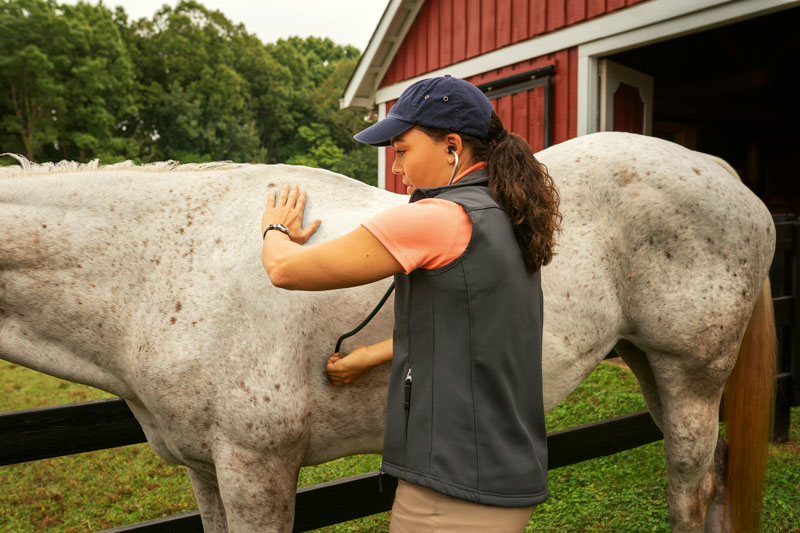
Biosecurity: Trusted Protection, Fast Detection
By Kevin Hankins, DVM, MBA, Managing Equine Technical Services Veterinarian, Zoetis
Sick horses are a lot like sick kids. Once one in the household catches a cold, it’s likely to spread through the entire family. When one horse shows signs of sickness, not only are they affected, but there is a risk that the virus can quickly spread to other horses in close proximity.
Influenza (flu) and equine herpesvirus (EHV, otherwise known as equine rhinopneumonitis) are the most common respiratory viruses in horses. Their incidence is increased in horses that travel, due to the stress of transportation and showing, and can potentially be spread to neighboring horses in the trailer and back on the farm.
The good news: You can reduce your horse’s risk of contracting these contagious respiratory diseases. Doing the right thing for your horse means taking both preventative and proactive measures to reduce the transmission, severity, and duration of disease, as well as identifying sick horses quickly to contain the spread of disease to other horses with biosecurity and quarantine measures.
Preventative Actions
Ultimately, everyone’s goal is to keep your horse happy and healthy.
This starts by vaccinating your horse for the five core diseases (West Nile virus, WNV; Eastern equine encephalitis, EEE; Western equine encephalitis, WEE; tetanus; and rabies) that every horse, everywhere may be exposed to regardless of their location, age, breed, or discipline.
Next, the most common risk-based respiratory diseases are flu and EHV. Ask your veterinarian to vaccinate against the flu and EHV at least 2 to 3 weeks prior to traveling. This will give you confidence that you are providing the protection your horse needs to help prevent respiratory illness from these two diseases.
Routine vaccines are only the first step. Prevention also includes taking precautions to limit the spread of disease before leaving home, on-site, and upon your return.
This checklist can help you create an outline for your barn’s biosecurity plan.
Before the Trip
• Ensure your horse’s vaccinations are up to date based on veterinarian recommendations.
• Confirm venue health requirements (e.g., up-to-date vaccination records, Coggins test, health certificate, passport) with enough advanced notice to get appropriate documentation from your veterinarian.
• Consider having your veterinarian run a serum amyloid A (SAA) stall-side test, which looks for this marker of inflammation and infection in a horse, to ensure there are no early indicators of infection prior to leaving. SAA is a major, acute-phase protein produced by the liver that is a reliable biomarker for inflammation due to infection.1
• Sanitize and pack individual water and feed buckets, tack, and equipment for travel.
• Pack a thermometer and an emergency kit.
At the Show or Rally
• Clean and disinfect the stall before unloading your horse.
• Limit nose-to-nose contact and any close contact with other horses.
• Ensure each horse has their own individual tack, equipment, and gear.
• Avoid shared water sources or buckets on-site.
• Every day, watch your horse’s behavior, and monitor his eating and drinking levels and manure production.
• Take your horse’s rectal temperature at least once daily (or as per venue requirements).
• Consider having the on-site veterinarian run an SAA stall-side test to give peace of mind that there are no signs of infection prior to competition and leaving for home.
• Watch for any signs of coughing, sneezing, or nasal discharge of any color. If noticed, contact the veterinarian right away.
Once Back Home
• For 14 days, avoid comingling or turning out your horse with other horses.
• Continue to take daily rectal temperature for 14 days.
• Watch for signs of illness, behavior change, fever, runny nose, coughing, or sneezing. Separate from others immediately if clinical signs appear.
• Consider having your veterinarian run an SAA within 14 days after returning home to ensure that there isn’t any underlying infection present.
• Clean and disinfect your trailer and any tack, equipment, or other items that went to the show.
Identifying which horses are sick, which have been exposed, and which may potentially get sick is critical for herd management and potential isolation.
Proactive Measures
Veterinarians can detect and measure infection in 10 minutes using a handheld diagnostic blood test that measures and quantifies serum amyloid A (SAA). The SAA levels quickly and significantly increase in response to an infection.
SAA has been shown to be 30 times more sensitive than a thermometer in identifying subclinical infection, before your horse even starts showing signs2, giving your vet a head start on treatment.
Knowing a horse is sick before registering a fever provides critical time to implement a plan of action for monitoring, isolating, and ultimately treating infected horses faster.
Set Up for Success
Don’t let a respiratory disease derail your riding and show season. Talk with your veterinarian today about preventive and proactive steps you can take to protect your horse and detect a problem before it gets out of hand. Learn more by visiting zoetisequine.com.
1 Jacobsen, Stine. Review of equine Acute-Phase proteins. AAEP Proceedings, Vol 53, 2007. Pages 230-235.
2 Oertly. et al. The accuracy of Serum Amyloid A in determining early inflammation in horses following long-distance transportation by air. AAEP Proceedings, 2017. Pages 460-461.

About Zoetis— Official USPC Equine Health and Wellness Partner
To learn more about how Zoetis is making lives better for horses and those who care for them, visit zoetisequine.com and Zoetis Equine on Facebook and Instagram.





